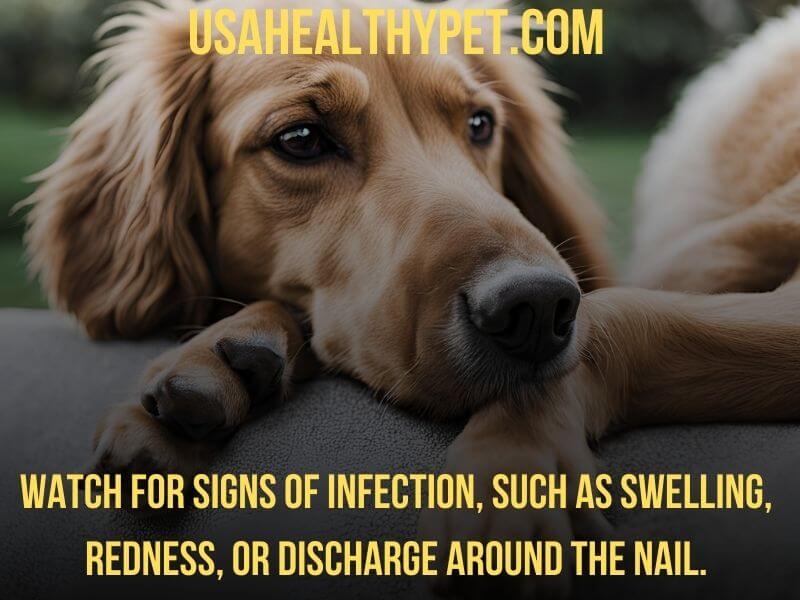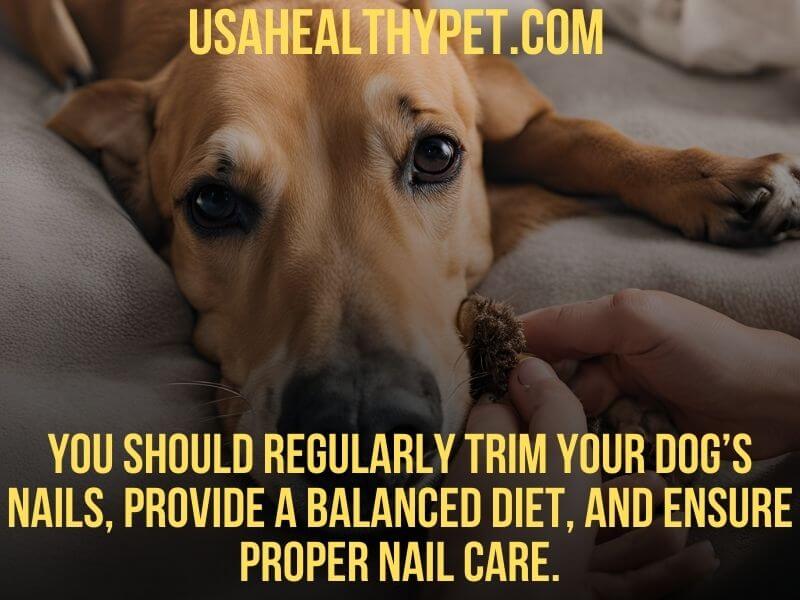When you notice your dog’s nails bending sideways, it can be worrying. This issue can arise from various causes such as injuries, genetics, poor nail care, or nutritional deficiencies.
In this article, we’ll explore the reasons behind bent nails, when to be concerned, and how to care for and prevent this issue.
- What to do When a dog Nail is Bent Sideways
- Understanding Dog Nail Anatomy
- Signs of a Dog’s Nail Bent Sideways
- Common Causes of Bent Nails
- Immediate Actions
- Prevention Tips
- Home Care for Bent Nails
- When to See a Veterinarian
- Preventive Measures for Healthy Nails
- The Role of Environment
- How to Trim Your Dog’s Nails Properly
- Alternative Nail Care Methods
- Conclusion
- FAQs
What to do When a dog Nail is Bent Sideways
You should regularly trim your dog’s nails, provide a balanced diet, and ensure proper nail care. If the problem persists, consult a veterinarian to rule out any underlying health issues.
According to the American Veterinary Medical Association (AVMA), if you notice your dog’s nail bending or breaking, it’s crucial to assess the extent of the damage.
Clean the affected area with mild antiseptic and monitor for signs of infection, such as swelling or discharge.
Understanding Dog Nail Anatomy
Dog nails are composed of a hard outer shell and a softer inner core called the quick, which contains blood vessels and nerves. Proper care is crucial to prevent issues like bent or overgrown nails.
Signs of a Dog’s Nail Bent Sideways
So, how do you know if your dog’s nail is bent sideways? Here are a few telltale signs:
- Limping or favoring one paw
- Whimpering or showing signs of pain when you touch the paw
- Swelling or redness around the nail
- Blood or obvious bending of the nail
If you notice any of these symptoms, it’s time to take a closer look.

Common Causes of Bent Nails
Injury or Trauma
One of the most common causes of bent nails in dogs is injury or trauma.
Dogs are active creatures, and they can easily get their nails caught in something or stub their toes while playing. This can cause the nail to bend or even break.
Research conducted by veterinary schools, such as the University of California, Davis, indicates that injuries are a leading cause of bent nails in dogs.
Dogs frequently injure their nails while playing, running, or getting caught in objects. This trauma can lead to nail bending or breaking.
Genetics and Breed-Specific Traits
Did you know that some breeds are more prone to nail issues than others? Genetics can play a big role in the shape and growth pattern of your dog’s nails.
For example, breeds with dewclaws (extra nails on the side of the paw) may experience more issues with bent nails.
Poor Nail Care and Overgrowth
If your dog’s nails are not trimmed regularly, they can grow too long and start bending sideways.
Overgrown nails can also cause discomfort and lead to more serious problems like infections or gait issues.
Nutritional Deficiencies
Just like humans, dogs need a balanced diet to stay healthy. Nutritional deficiencies, particularly a lack of essential vitamins and minerals, can affect the health of your dog’s nails.
Weak, brittle nails are more prone to bending and breaking.
When to Worry About Bent Nails
Not all bent nails are a cause for concern. However, if you notice persistent issues or if your dog seems to be in pain, it’s time to take action.
Watch for signs of infection, such as swelling, redness, or discharge around the nail.
Immediate Actions
Alright, now for the practical stuff. If you find your dog’s nail bent sideways, here’s what to do:
- Stay Calm: Your dog will pick up on your energy, so try to stay as calm and reassuring as possible.
- Examine the Paw: Gently check the affected nail. If your dog is in too much pain, you might need to take a break and try again later.
- Clean the Area: If there’s any blood or dirt, clean the area with mild soap and warm water. Pat it dry gently.
- Trim the Nail (If Possible): If the nail is only slightly bent and you feel comfortable, you can try to trim the damaged part. Be very careful to avoid the quick.
- Bandage the Paw: Wrap the paw lightly with a bandage to protect it from further injury.
Prevention Tips
To prevent future nail injuries, here are some handy tips:
- Regular Trimming: Keep your dog’s nails trimmed to a healthy length.
- Paw Checks: Regularly check your dog’s paws for any signs of injury or wear.
- Exercise on Soft Surfaces: Try to avoid hard or rough surfaces that can cause wear and tear.
- Diet and Health: Ensure your dog has a balanced diet rich in nutrients to keep their nails strong.

Home Care for Bent Nails
Regular Trimming
One of the best ways to prevent and correct bent nails is by keeping them trimmed. Regular trimming helps maintain the proper length and shape of your dog’s nails, reducing the risk of bending and other issues.
Dr. Wooten, a well-known veterinarian and author, emphasizes the importance of regular nail trimming. “Regular nail care is essential to prevent overgrowth, which can cause nails to bend sideways. Long nails can create an unnatural gait and lead to further health issues,”
Note: The expert opinion was found with the help of ChatGPT.
Proper Diet and Supplements
A healthy diet is essential for strong nails. Ensure your dog is getting a balanced diet rich in vitamins and minerals. Supplements like biotin or omega-3 fatty acids can also promote nail health.
When to See a Veterinarian
Persistent Issues
If your dog’s nails continue to bend despite regular care, it’s time to consult a veterinarian. There could be an underlying issue that needs professional attention.
Signs of Infection
Infections can be serious and require prompt treatment. If you notice any signs of infection, such as pus or an unpleasant odor, seek veterinary care immediately.
Underlying Health Conditions
Sometimes, bent nails can be a symptom of a larger health issue, such as a metabolic disorder or autoimmune disease. A vet can run tests to rule out any serious conditions.
Preventive Measures for Healthy Nails
Routine Checks
Make it a habit to check your dog’s nails regularly. This way, you can catch any issues early and take action before they become serious problems.
Using the Right Tools
Invest in quality nail trimming tools designed for dogs. This makes the process easier and safer for both you and your pet.
The Role of Environment
Dr. Sarah Wooten highlights the impact of the environment on nail health. “Encouraging your dog to walk on hard surfaces like sidewalks or gravel can naturally wear down nails and prevent overgrowth,”
She suggests. Adjusting environmental conditions can contribute to overall nail health and reduce the need for frequent trimming.
Note: The expert opinion was found with the help of ChatGPT.
Indoor vs. Outdoor Dogs
Where your dog spends most of their time can affect their nail health. Outdoor dogs might naturally wear down their nails on hard surfaces, while indoor dogs may require more frequent trims.
Surfaces and Nail Wear
Different surfaces can affect how your dog’s nails wear down. For instance, concrete or asphalt can help keep nails trimmed naturally, while soft grass or carpet won’t have the same effect.
How to Trim Your Dog’s Nails Properly
Trimming your dog’s nails might seem daunting, but it’s essential for their health. Let’s break it down step-by-step to make it easier for you.
Tools for Nail Trimming
Having the right tools can make a world of difference. Here’s what you’ll need:
- Nail clippers specifically designed for dogs
- Styptic powder in case of any bleeding
- Treats to reward your pup and keep them calm
Step-by-Step Nail Trimming Guide
- Get your dog comfortable. Find a quiet spot and have them sit or lie down.
- Hold the paw gently. Make sure you have a good grip but don’t squeeze too hard.
- Trim a little at a time. It’s better to trim small amounts frequently than to cut too much at once.
- Use styptic powder if needed. If you accidentally cut the quick, apply styptic powder to stop the bleeding.
- Reward your dog. Give them a treat and plenty of praise to make the experience positive.
Alternative Nail Care Methods
Nail Grinders
If you’re not comfortable using clippers, nail grinders can be a great alternative. They file the nails down gradually and can be easier to control.
Natural Wear and Tear
Encourage your dog to walk on hard surfaces like sidewalks. This can help naturally wear down their nails and reduce the need for frequent trims.
The Importance of Regular Vet Visits
Regular veterinary check-ups are crucial for your dog’s overall health, including their nails. Your vet can spot any issues early and provide professional advice on nail care.
Conclusion
Bent nails in dogs can be concerning, but with the right care and attention, you can keep your furry friend’s paws in top shape.
Remember to trim regularly, provide a balanced diet, and consult your vet if you notice any persistent issues. By taking these steps, you’ll ensure your dog stays happy, healthy, and comfortable.
FAQs
1. Can bent nails cause pain for my dog?
Yes, bent nails can cause discomfort and pain, especially if they lead to infections or affect your dog’s gait.
2. How often should I trim my dog’s nails?
It depends on the dog, but generally, trimming every 3-4 weeks is a good rule of thumb.
3. What should I do if I accidentally cut the quick?
Apply styptic powder to stop the bleeding and soothe your dog. Be more cautious in the future to avoid cutting too close.
4. Are there any supplements that can help with nail health?
Yes, supplements like biotin and omega-3 fatty acids can promote healthier nails.
5. Can I use human nail clippers on my dog?
It’s best to use clippers specifically designed for dogs to avoid injury and ensure a clean cut.

Pingback: Poodle Tails: Docked vs. Undocked - Pros and Cons